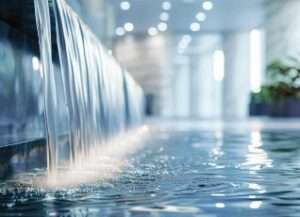Sediment in your building’s water system can cause damage to plumbing, increase maintenance costs, and promote bacterial growth. To ensure your building water system runs smoothly and efficiently, it’s crucial to understand what sediment is, how it enters your water system, and strategies to control it.
Sediment in building water systems
Sediment is a naturally occurring material that gets into source water from soil runoff or the breakdown of organic materials. It can get into a building’s water system from:
- Incoming water supply: Decades of sediment on the interior of pipes can be disturbed by hydrant flushing, water main breaks, and other disruptive events. As water travels to your facility, it can pick up this loose sediment.
- Old and corroded plumbing: Plumbing equipment corrodes over time due to age or exposure to elements that degrade it. As this happens, particulate is released into the water.
- Construction and renovation: Increases in sediment can occur from construction-related excavations and water main breaks. Pressure changes (turning on and off the pumps and valves) can disrupt accumulated sediment and release it throughout the water system.
Sediment’s impact on plumbing
Too much sediment in a building’s water system can damage plumbing, increase operational costs, and reduce the life expectancy of equipment, including:
- Pipes and valves: Sediment buildup can clog pipes and lead to poor operation of mixing valves. It also increases pipe corrosion as it rubs against walls and joints, eventually causing leaks.
- Recirculation pumps: Sediment buildup can shorten the normal life of these pumps – in some cases, pumps need to be replaced every two to three years instead of their normal lifespan of ten years.
- Fixtures: Sediment can build up in sinks, showerheads, and aerators causing clogging, discolored water, and increased bacterial growth.
Sediment’s impact on bacterial growth
High sediment loads can encourage bacterial growth, increasing a facility’s risk of disease outbreak, like Legionnaire’s Disease. Three key ways sediment increases bacterial growth include:
- Serves as a food source: Sediment is high in carbon and provides constant food for waterborne pathogens.
- Uses up disinfection: Supplemental disinfectants treat everything in the water, including sediment. This uses up the disinfectant unnecessarily.
- Protects bacteria: Sediment can shield bacteria from disinfectant.
Benefits of controlling sediment in building water systems
The benefits of controlling sediment in your building water system include:
- Reduce and control bacterial growth
- Improve functionality and life of equipment
- Reduce pump and valve failure
- Reduce the cost of equipment failure
- Reduce damage to plumbing infrastructure
- Reduce operational costs
How to control sediment in building water systems
There are several ways facilities can control sediment in their building water system, including:
- Flushing: Routine flushing can replace aging water and purge accumulated sediment. Flushing programs should be customized to a facility depending on water system size, components, water flow, and sediment levels.
- Cleaning: Routine cleaning of equipment reduces sediment accumulation. The equipment to consider cleaning may include storage tanks, water softeners, heaters, expansion tanks, mixing valves, and cooling towers.
- Sediment filtration: A sediment filtration system can remove sediment from the building water system. Different types of sediment filters include bag, cartridge, sand, and screen filters.
Sediment filtration case study
A newly built facility in Colorado began experiencing issues with its plumbing infrastructure soon after opening its doors to patients in 2016, including:
- Sediment buildup in the building’s hot water recirculation line.
- Two to four pinhole leaks per month resulting in premature pipe replacement costs of $80,000.
A sediment test by LiquiTech uncovered 26 times the World Health Organization-recommended sediment levels entering the building from the incoming water supply. Installing a new LiquiTech Sediment Filtration System removed 96.7% of incoming sediment, helping the facility:
- Improve water quality.
- Reduce the risk of Legionella and other bacterial growth.
- Reduce maintenance time and costs.
- Extend the life of the new pipe and other water-bearing equipment.
- Avoid $80,000 in future pipe replacement costs.
Installing a sediment filtration system is an effective way to control sediment, improve water quality, and extend the life of plumbing equipment. It can also result in cost savings for facilities by reducing maintenance and equipment replacement costs.
For more insights on controlling sediment in your building water system, contact us today. Our team of ASSE 12080 Certified Legionella Water Safety and Management Specialists can work with you to develop a solution that’s tailored to your specific needs.


